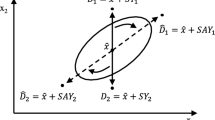Abstract
The notion of phase tracking has found its applications in signal processing, navigation system, radar and communication systems. The nonlinear phase tracking filtering is attributed to nonlinear noisy observables that combines dynamics and observables. The precised phase angle estimation is always a potential task in practical problems. With this motivation, in this paper, we propose a new estimation method, which is a relatively very scarce, but exploits an appealing framework because of its concerning algorithmic convenience stemming from the bilinearizability. The novelty of the method is the Carleman linearization-based filtering. The Carleman linearization-based phase tracking filtering is contrasted with the two-benchmark filters, the EKF and a second-order Gaussian filtering. This paper develops a phase tracking filtering algorithm in the Carleman framework for the case, where the process noise is the OU process and measurement system noise is the Wiener process. Notably, this paper develops mathematics of stochastic phase tracking problem in the Carleman framework.





Similar content being viewed by others
References
Curran JT (2015) Enhancing weak-signal carrier phase tracking in GNSS receivers. Int J Navig Obs. https://doi.org/10.1155/2015/295029
Willsky A (1974) Fourier series and estimation on the circle with applications to synchronous communication-I: analysis. IEEE Trans Inf Theory 20(5):577–583. https://doi.org/10.1109/TIT.1974.1055280
Willsky A (1974) Fourier series and estimation on the circle with applications to synchronous communication-II: implementation. IEEE Trans Inf Theory 20(5):584–590. https://doi.org/10.1109/TIT.1974.1055281
Chen S, Gao Y (2017) Improvement of carrier phase tracking based on a joint vector architecture. Int J Aerosp Eng. https://doi.org/10.1155/2017/9682875
Schuss Z (2012) Nonlinear filtering and optimal phase tracking, applied mathematical sciences. Springer, New York
Kerr TH (1991) Streamlining measurement iteration for EKF target tracking. IEEE Trans Aerosp Electron Syst 27(2):408–421. https://doi.org/10.1109/7.78314
Bhatt DS, Sharma SN (2020) Carleman linearization based estimation technique for a noise influenced electronic circuit. Electron Lett 56(12):589–592. https://doi.org/10.1049/el.2019.4197
Sharma SN, Parthasarathy H, Gupta JRP (2006) Third-order approximate Kushner filter for a non-linear dynamical system. Int J Control 79(9):1096–1106. https://doi.org/10.1080/00207170600800124
Rugh WL (1980) Nonlinear system theory: the Volterra-Wiener approach. Johns Hopkins University Press, Baltimore
Kawalski K, Steeb WH (1991) Nonlinear dynamical systems and Carleman linearization. World Scientific, Singapore
Kloden PE, Platen E (1999) Numerical solution of stochastic differential equations. Springer-Verlag, Berlin
Li F, Shi P, Wu L (2017) Control and Filtering for Semi-Markovian Jump Systems. Springer, Berlin
Carleman T (1932) Application de la théorie des équations intégrales linéaires aux systémes d’ équations différentialles non Linéaires (in French). Acta Math 59:63–87
Brewer JW (1978) Kronecker products and matrix calculus in system theory. IEEE Trans Circuits Syst 25(9):772–781. https://doi.org/10.1109/TCS.1978.1084534
Karatzas I, Shreve SE (1988) Brownian motion and stochastic calculus. Springer, New York
Pugachev VS, Sinitsyn IN (1977) Stochastic Differential Systems (Analysis and Filtering), John-Wiley and Sons, New York and Chichester
Jazwinski AH (1970) Stochastic processes and filtering theory. Academic Press, New York and London
Huber M (2015) Nonlinear Gaussian Filtering: Theory, Algorithms, and Applications, Habilitation thesis
Hirpara RH, Sharma SN (2013) On a phase tracking problem: nonlinear filtering approaches. In: 3rd International Conference on Systems and Control, Algiers, pp 596–601. https://doi.org/10.1109/ICoSC.2013.6750922
Acknowledgements
The authors are grateful to the anonymous qualified reviewers for commenting on the initial version of the paper that has improved the contents of the paper.
Author information
Authors and Affiliations
Corresponding author
Ethics declarations
Conflict of interest
The authors declare that they have no conflict of interest.
Appendix
Appendix
Consider the Carleman linearized Itô bilinear SDE,
We wish to calculate the expectation of the term \(E(d\xi_{t} d\xi_{t}^{T} ).\) The term signifies the diffusion coefficient term in the variance evolution of the filtering. Thus,
and
After applying the Itô differential rule, we have
where \(\overbrace {{\xi_{t} \xi_{t}^{T} }}^{\Lambda } = E(\xi_{t} \xi_{t}^{T} \left| {t_{0} } \right.,\xi_{{t_{0} }} ) = V_{t} + \overset{\lower0.5em\hbox{$\smash{\scriptscriptstyle\frown}$}}{\xi }_{t} \overset{\lower0.5em\hbox{$\smash{\scriptscriptstyle\frown}$}}{\xi }_{t}^{T} .\) Recall the Riccati equation in the linear filtering. The generalization of the Riccati equation is natural because of the bilinearity. The ‘generalized’ Riccati equation combines the Riccati equation and the corrections to the diffusion coefficient, i.e. the terms associated with the coefficient of the term \(dt\) of the right-hand side of the above equation. Thus, the variance evolution of the Carleman linearized SDE is a generalized Riccati equation, i.e.
Rights and permissions
About this article
Cite this article
Medewar, P.G., Sharma, S.N. & Patel, H.G. Carleman framework-based filtering for a nonlinear phase tracking problem. Int. J. Dynam. Control 11, 194–204 (2023). https://doi.org/10.1007/s40435-022-00937-1
Received:
Revised:
Accepted:
Published:
Issue Date:
DOI: https://doi.org/10.1007/s40435-022-00937-1




